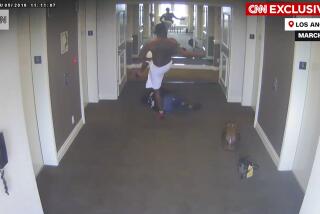No Rest for Victims of Stalking
- Share via
The list of stalking victims reads like a Who’s Who of Hollywood.
Jodie Foster, Justine Bateman and Michael J. Fox are among those who have been pursued by obsessed fans over the years.
Some of the celebrities have received late-night phone calls and threatening mail. Others have encountered tragedy.
Actress Theresa Saldana survived a brutal stabbing at the hands of an obsessed fan, and sitcom star Rebecca Schaeffer was shot to death on her doorstep by a man who once had shown up on her set with a teddy bear and flowers.
Now the list of celebrity stalking victims has grown by one. Madonna testified in chilling detail this week about the terror she has felt in the wake of alleged stalking by Robert Dewey Hoskins, who is on trial for stalking and making terrorist threats against the entertainer, her bodyguard and her secretary. Hoskins also is charged with assaulting the bodyguard. He has pleaded not guilty to all charges.
Madonna said the ordeal has caused her nightmares, and that she plans to sell her Hollywood Hills home, where Hoskins jumped a wall in May and was shot by a bodyguard during the encounter.
Victims, police and psychiatrists say that Madonna’s testimony offers a rare glimpse into the terror that such victims endure, which few are willing to discuss openly for fear of once again attracting their stalkers.
Indeed, several celebrities contacted for this story declined to comment, preferring to put their ordeals behind them. But the victims who were willing to speak agreed that Madonna’s life may never be the same.
“Even if her bodyguards can protect her, Madonna still feels that terror,” said Joy Silverman, a spokeswoman for the anti-stalking program of the National Victim Center in New York. “It’s psychological rape.”
Silverman was stalked for more than a year by the former chief judge of New York, Sol Wachtler, in a highly publicized case two years ago. The judge served 13 months in prison after pleading guilty to threatening to kidnap Silverman’s daughter.
“I empathize with Madonna because I understand exactly what she is feeling,” said Silverman, who said the stalking in her case started after she and Wachtler ended a personal relationship. “No matter how protected you are, you feel completely vulnerable. If somebody wants to get you, they are going to get you.”
Psychologists and police offer a range of theories to explain stalking. The experts say that many stalkers abuse drugs or suffer mental disorders such as schizophrenia and depression.
Some experts believe that celebrity stalking may be an outgrowth of what they call the “cult of personality” that develops around Hollywood’s big-name entertainers. “There’s something more exciting about stalking a well-known star who you have seen virtually nude than somebody down the street who is much more ordinary,” said Mark J. Mills, a clinical professor at UCLA’s department of psychiatry.
Whatever the reasons, stalkers have been known to go to great lengths to reach their victims.
Robert John Bardo, convicted in the 1989 murder of Rebecca Schaeffer, hired a private detective to track down the actress. The detective located Schaeffer’s home address from the California Department of Motor Vehicles, a fact that led to restrictions on public access to DMV records.
In the Madonna case, Hoskins tried twice to reach the star by climbing over the wall of her Hollywood Hills home, her bodyguard testified. A videotape seen by the jury shows a figure, whom the bodyguard says is Hoskins, jumping from the wall onto Madonna’s property, looking in her front door.
Similar incidents prompted the Los Angeles Police Department in 1990 to establish a special unit to deal with stalking.
The Threat Management Unit handles about 200 stalking cases a year, and about a third involve celebrities, said Det. Greg Boles, assistant officer in charge of the unit.
Boles said the Madonna case publicizes the ugly crime of stalking but also fuels the imaginations of those considering such activity, particularly against celebrities.
“The whole idea of stalking is becoming more well known because of cases like this,” said Boles, whose unit is the first of its kind in the country.
The stalking unit tries to educate victims, teaching them to obtain restraining orders and to document stalking activity for use in court. The 10 officers in the unit also inform victims about laws that can help them.
California made stalking a crime in 1990, becoming the first state to do so. Every state but Maine has since enacted such a law.
The California law, adopted after a series of women, including Schaeffer, were followed or attacked, made stalking a misdemeanor, punishable by up to a year in county jail and a $1,000 fine. The crime can now be upgraded to a felony that carries a four-year sentence in state prison. The charges against Hoskins are all felonies.
The original definition of stalking covered victims who had a reasonable fear of death or great bodily injury. The definition has been broadened to cover victims who have a reasonable fear for their safety or the safety of their family.
Many victims say the state law was long overdue. They also question whether even the most stringent measures will protect victims against relentless stalkers.
“We’re living in the freest country, and yet victims of stalking have no freedom because they are afraid to open their mail, to answer the phone, to enter a restaurant,” said Silverman of the victims group in New York. “It’s a terrible, terrible crime, one that takes away your dignity.”
More to Read
The biggest entertainment stories
Get our big stories about Hollywood, film, television, music, arts, culture and more right in your inbox as soon as they publish.
You may occasionally receive promotional content from the Los Angeles Times.










